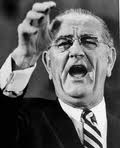Using Place to Reveal a Person
Biff Barnes
Why did Lyndon Johnson always seem to be running when he came to work on Capitol Hill?
Andrea Pitzer writing on the Neiman Storyboard reports that Pulitzer Prize winning biographer Robert Caro explained the answer to the Second Annual Compleat Biography Conference at the National Press Club in Washington D.C. Caro, who won the Pulitzer for his 1975 book on Robert Moses and again in 2003 for the third volume of his study of Johnson, Master of the Senate, focused on the importance of setting in biography.

“The greatest of books are books with places you can see in your mind’s eye…,” said Caro. “If the place is important enough in the character’s life; if on the most basic level he spent enough time in it…; if the place, the setting, played a crucial role in shaping the character’s feelings, drives, motivations, insecurities, then by describing the place well enough, the author will have succeeded in bringing the reader closer to an understanding of the character without giving him a lecture, will have made the reader therefore not just understand but empathize with a character, will have made the readers’ understanding more vivid, deeper than any lecture could.”
To illustrate his point Caro used an example from his Johnson biography. He wanted to capture Johnson’s experience when, fresh from the isolated, empty, inhuman landscape of Johnson City, Texas, he first arrived at the Capitol. Caro interviewed a congressional aide who knew LBJ when he first served in the House of Representatives. She described seeing Johnson coming across Capitol Hill in the morning. She said he always seemed to be running.

Caro went to the place and took the same route to the Capitol Johnson had taken to see why. Although he took the walk several times he couldn’t figure it out. Then he remembered that Johnson was from farm country and would likely have been an early riser. Caro took the walk again just after dawn and found the east side of the Capitol Building lit up and glowing in the sunlight. He used the insight in this passage from his book:
“When Lyndon Johnson first came to Washington, he lived in the basement of a shabby little hotel, in a tiny cubicle across whose ceiling ran bare steam pipes. Its slit of a window stared out across a narrow alley at the weather-stained red brick wall of another hotel. Leaving his room early in the morning, Lyndon would turn left down the alley, walking between the red brick walls of other shabby hotels, but when he turned the corner at the end of that alley, suddenly before him at the top of a long gentle hill would be not brick but marble, a great shadowy mass of marble. Marble columns and marble arches and marble parapets, and a long marble balustrade high against the sky. Veering along a path to the left, he would come up Capitol Hill and around the corner of the Capitol, and the marble of the eastern façade, already caught by the early morning sun, would be a gleaming, brilliant, almost dazzling white.
A new line of columns, towering columns, marble for magnificence and Corinthian for grace, stretched ahead of him, a line of columns so long that columns seemed to be marching endlessly before him, the long friezes above them crammed with heroic figures. And columns loomed not only before him but above him. There were columns atop columns, columns in the sky. For the huge dome that rose above the Capitol was circled by columns not only in its first mighty upward thrust, where it was rimmed by 36 great pillars for the 36 states that the Union had comprised when it was built, it was circled by columns also high above, 300 feet above the ground, where just below the statue of Freedom, a circle of 13 smaller, more slender shafts for the 13 original states created a structure that looked like a little temple in the sky, adding a grace note to a building as majestic and imposing as the power of the sovereign state that it has been designed to symbolize. And as Lyndon Johnson came up Capitol Hill in the morning, he would be running.”
The image tells you more about Lyndon Johnson than you could learn from pages of explanation by the author.
It’s a great lesson for family historians trying to gain some understanding of ancestors about whom stories and details are scarce. By visiting places that were important to them and experiencing those places as they might have you can sometimes gain an insight into what their life might have been like which will help both you and your readers know who they were.